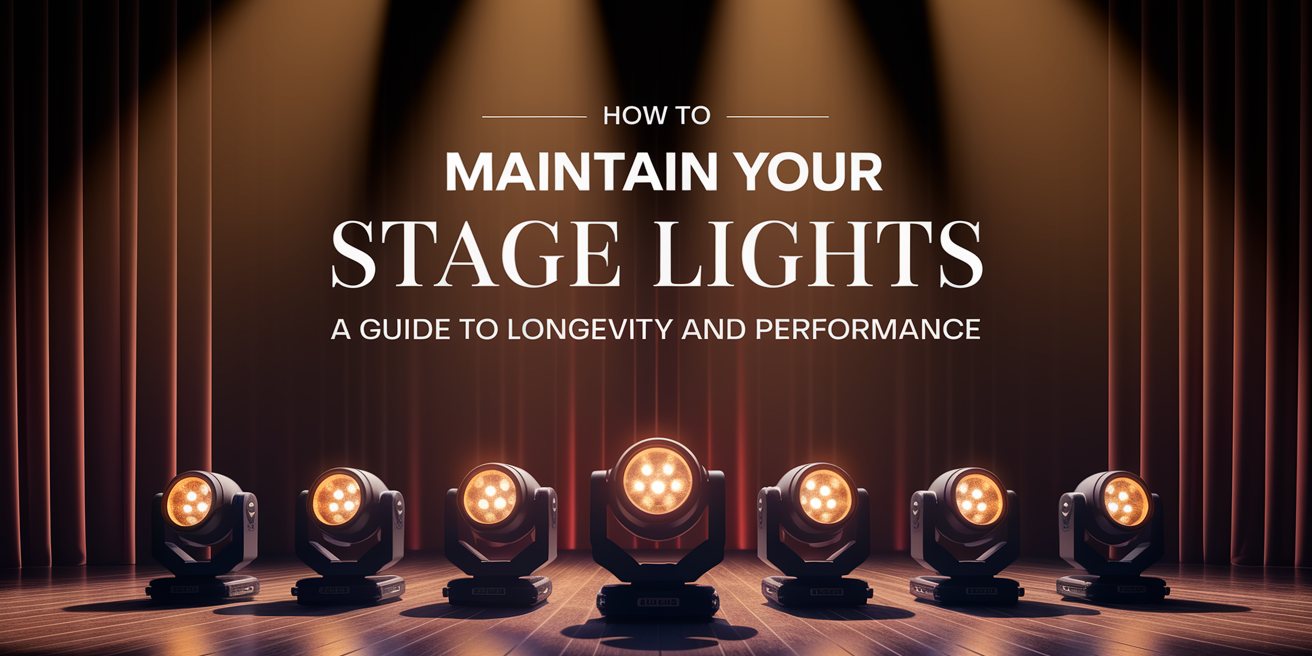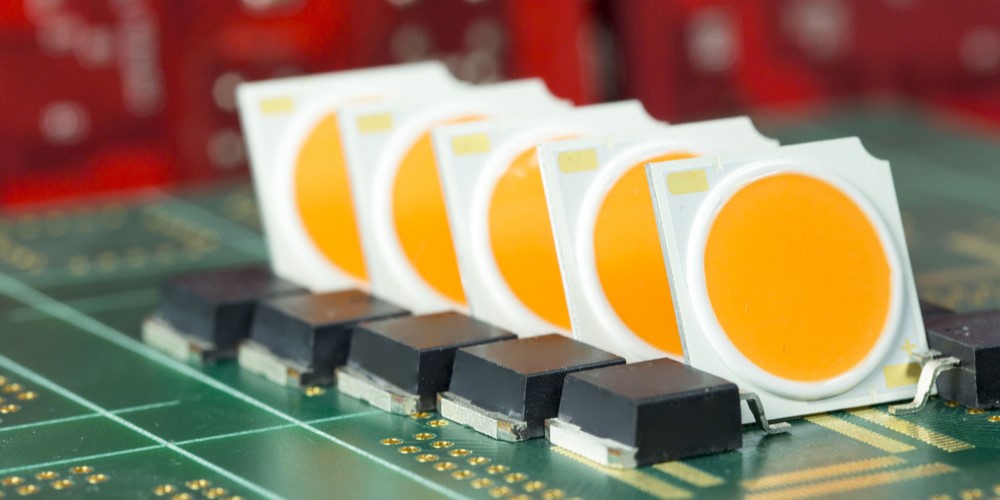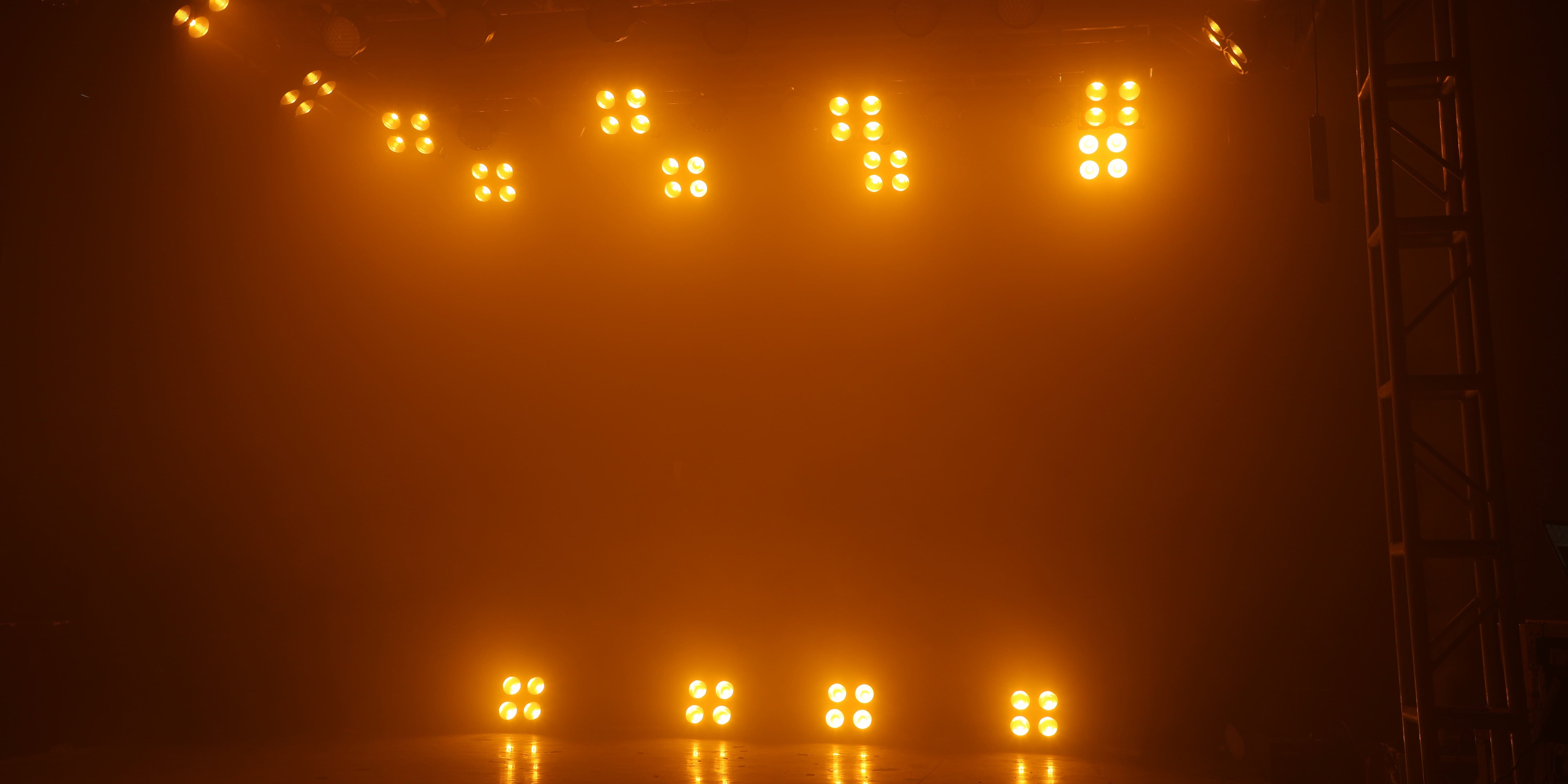Bühnenbeleuchtung ist das Herzstück jeder Live-Performance. Sie verwandelt gewöhnliche Bühnen in herausragende. Diese komplexen Systeme erfordern jedoch sorgfältige Pflege, um Zuverlässigkeit, Sicherheit und optimale Leistung zu gewährleisten. Mangelnde Wartung der Geräte kann zu Fehlfunktionen, Sicherheitsrisiken oder teuren Ersatzgeräten führen.
Wir helfen Ihnen dabei, die besten Praktiken der Branche zu übernehmen, um sicherzustellen, dass Sie die Wartung Ihrer Bühnenbeleuchtung verwalten, die Lebensdauer Ihrer Ausrüstung verbessern und temporäre Aufführungen liefern können.
Warum ist die Wartung der Bühnenbeleuchtung wichtig?
Regelmäßige Wartung hilft, Überhitzung, Flackern und vorzeitiges Durchbrennen der Glühbirne zu vermeiden. Staubablagerungen, Belüftungsprobleme und elektrische Fehler tragen häufig zur Verschlechterung der Geräteleistung bei.
Regelmäßige Wartung schützt Ihre Investition und stellt sicher, dass Ihr Projektor helle, präzise Farben liefert und sicher funktioniert. Durch die Priorisierung von Wärmemanagement und Konnektivität wird die Langlebigkeit und Showqualität Ihrer Leuchte gewährleistet.
Checkliste für die Beleuchtungswartung
Pflegen Sie Ihre Bühnenbeleuchtung ist für die Gewährleistung von Leistungszuverlässigkeit und Langlebigkeit unerlässlich. Regelmäßige Wartung hilft, unerwartete Ausfälle zu vermeiden und Ihre Geräte in optimalem Zustand zu halten.
Kontrollen vor der Veranstaltung
Führen Sie eine 30-minütige Aufwärmphase mit 50 % Intensität durch und lassen Sie die Lampen 30 Minuten lang eingeschaltet, bevor Sie sie einschalten. Diese langsame Erwärmung stabilisiert interne Komponenten wie Vorschaltgeräte und Glühfäden und minimiert den thermischen Nebenstrom bei voller Leistung.
Schalten Sie die Geräte nach 15 Minuten Laufzeit für einige Minuten aus, um die Restwärme zu entfernen, und aktivieren Sie sie dann für die Veranstaltung erneut.
Überprüfen Sie gleichzeitig, ob alle Glühbirnen gleichmäßig leuchten und stellen Sie sicher, dass die Anschlüsse weder locker noch korrodiert sind. Das schnelle Festziehen der Fassungen und der Austausch ausgefranster Kabel verhindert Lichtbögen oder zeitweise Ausfälle und Ausfallzeiten während des Betriebs.
Kontrollen nach der Veranstaltung
Lassen Sie die Geräte nach der Veranstaltung 15–20 Minuten abkühlen, bevor Sie die Stromversorgung trennen. Plötzliche Abschaltungen führen zu Wärmestau im Gehäuse und beschleunigen den Verschleiß der Komponenten.
Decken Sie die Leuchten nach dem Abkühlen mit antistatischen Staubschutzhüllen ab, um das Eindringen von Partikeln zu verhindern, die die Linsen zerkratzen oder die Lüftungssysteme verstopfen können. Verwenden Sie in feuchten Umgebungen feuchtigkeitsbeständige Abdeckungen, um alle LED-Panels vor Kondensationsschäden zu schützen.
Gründliche Reinigung
Reinigen Sie die Außenflächen regelmäßig mit einem Mikrofasertuch und einem pH-neutralen Reiniger, um die Linsenbeschichtung nicht zu beschädigen. Verwenden Sie trockene Druckluft (unter 50 psi), um Staub von internen Komponenten wie Kühlkörpern, Lüftern und Reflektoren zu entfernen. Bei hartnäckigem Fett entfernen Sie rückstandslos Isopropylalkohol (70 %) auf LED-Leuchten.
Elektrische Sicherheitsprüfungen
Überprüfen Sie alle Kabel, einschließlich Strom- und DMX-Kabel, auf Risse oder Beschädigungen, insbesondere an stark beanspruchten Stellen wie Klemmen oder Traversen. Ersetzen Sie beschädigte oder brüchige Kabel umgehend.
Stellen Sie sicher, dass die Überspannungsschutzgeräte die UL 1449-Zertifizierung besitzen und Spitzenleistungen bewältigen können, um Spannungsspitzen zu vermeiden, insbesondere wenn Dimmer verwendet werden.
Schmierung mechanischer Komponenten
Schmieren Sie bewegliche Teile wie Farbräder, Schwenk-/Neigemechanismen und Motoren mit PTFE- oder Silikonschmiermitteln. Vermeiden Sie Produkte auf Erdölbasis, da diese Kunststoffe beschädigen und bei Erwärmung Dämpfe freisetzen können.
Überprüfung des Belüftungssystems
Prüfen Sie, ob Lüfterblätter und Filter frei von Staub und Schmutz sind, der den Luftstrom behindern könnte. Verstopfte Lüftungsöffnungen können die Innentemperatur erhöhen und die Lebensdauer der Komponenten verkürzen. Stellen Sie sicher, dass keine Vorrichtungen oder Kabel die Lüftungswege blockieren, insbesondere bei kanalisierten Kühlsystemen.
Brandschutzprüfungen
Überprüfen Sie die Verkabelung regelmäßig auf Risse oder Verschleiß, insbesondere in der Nähe von Bereichen mit hoher Hitze wie Dimmern.Stellen Sie sicher, dass die Feuerlöscher vollständig geladen und für elektrische Brände (Klasse C) geeignet sind. Ersetzen Sie Feuerlöscher, die älter als 12 Jahre sind oder Druckunregelmäßigkeiten aufweisen.
Vorrichtungseinstellung
Setzen Sie die Schwenk-/Neige-Encoder zurück, um Positionsabweichungen zu korrigieren, insbesondere nach längerem Gebrauch. Für DMX512 Überprüfen Sie bei Controllern, ob die Adresszuweisungen und Kanalhierarchien mit den Patchblättern übereinstimmen. Verwenden Sie Kolorimeter, um die LED-Ausgabe zu messen und die RGB-Mischungen zu optimieren, um die Farbgenauigkeit zu gewährleisten.
Fehlerbehebung bei häufigen Problemen mit der Bühnenbeleuchtung
Trotz regelmäßiger Wartung Bühnenbeleuchtung Es kommt nicht selten vor, dass Betriebsprobleme auftreten, die auf Umweltfaktoren, Verschleiß oder Konfigurationsfehler zurückzuführen sein können. Ihre schnelle Lösung garantiert eine unterbrechungsfreie Leistung und vermeidet unnötige Nebeneffekte auf die anderen Komponenten.
Hier analysieren wir drei häufige Probleme, ihre Ursachen und Maßnahmen zur Wiederherstellung ihrer Funktionsfähigkeit.
Flackernde Lichter
Flackerndes Licht wird oft durch lose Glühbirnen, schlechte elektrische Anschlüsse oder instabile Spannung aufgrund überlasteter Stromkreise oder defekter Dimmer verursacht. Gegen Ende der Lebensdauer von Lampen kann Flackern auch auf verschlissene Glühfäden oder die Verschlechterung von LED-Komponenten zurückzuführen sein.
Lösung: Schalten Sie die Leuchte aus, entfernen Sie die Glühbirne und setzen Sie sie wieder ein, um sicherzustellen, dass sie richtig sitzt. Überprüfen Sie mit einem Multimeter die Spannungsstabilität an der Steckdose. Schwankungen über ±10 % deuten darauf hin, dass ein separater Stromkreis erforderlich ist. Ersetzen Sie die Lampen gemäß den Lebensdauerempfehlungen des Herstellers, um Ausfälle während der Vorstellung zu vermeiden, insbesondere bei älteren Glühbirnen.
Überhitzung der Armaturen
Übermäßige Hitze kann Komponenten beschädigen und Brandgefahr verursachen. Verstopfte Lüftungsschlitze oder falsch verlegte Kabel können die Hitze in den Geräten stauen. Hohe Umgebungstemperaturen (über 45 °C) können die Überhitzung verschlimmern, insbesondere in schlecht belüfteten Räumen.
Lösung: Blasen Sie Kühlkörper und Lüftungsschlitze mit Druckluft aus, um Staub zu entfernen und die Luftzirkulation zu verbessern. Stellen Sie sicher, dass die Leuchtmittel die vom Hersteller empfohlene Wattzahl haben, und vermeiden Sie die Platzierung von Leuchten in Bereichen mit Hitzestau. Wenn die Temperaturen dauerhaft die zulässigen Grenzwerte überschreiten, installieren Sie zusätzliche Lüfter oder verbessern Sie die Belüftung.
Abnormale Farbausgabe
Licht ist designt, und Farben beeinträchtigen die Integrität des Lichtdesigns. Schmutzige Farbfilter oder Gele sammeln gerne Staub und Rauchrückstände und sind ein unangenehmes kleines Geheimnis, das entweder die Sättigung dämpft oder Farbtöne verschiebt. Die Verwendung der falschen Geltypen (e.g., LEE 101, wenn LEE 102 einen höheren Abschluss enthält, wird benötigt für Tageslichtweiß) ist ein weiterer schädlicher Filter für die Ausgaben.
Lösung: Reinigen Sie die Filter mit einem sicheren, nicht scheuernden Reiniger und ersetzen Sie verblasste Filterfolien. Überprüfen Sie die Einstellungen des DMX-Controllers, um die korrekte Kanalzuordnung und die korrekten Geräteprofile sicherzustellen. Kalibrieren Sie bei LED-Geräten die RGB-Werte über die Steuerungssoftware oder die integrierten Menüs neu, um eine präzise Farbausgabe wiederherzustellen.
Hinweise zur Lagerung und zum Transport
Um Leuchten vor Feuchtigkeit, Staub und Stößen zu schützen, lagern Sie sie in trockenen, klimatisierten Räumen (20–25 °C, unter 50 % Luftfeuchtigkeit). Verwenden Sie Silicagel-Packungen, um Kondensation zu vermeiden.
Verwenden Sie für den Transport spezielle Flightcases mit Schaumstoffeinlagen, um Schäden im Inneren zu vermeiden. Vermeiden Sie das Stapeln und verpacken Sie empfindliche Komponenten mit antistatischem Material. Transportieren Sie die Koffer stets aufrecht und beschriften Sie den Inhalt deutlich, um eine sichere Handhabung zu gewährleisten.
Wann Sie professionelle Hilfe suchen sollten
Wenn Sie wiederholte Stromausfälle, Brandgeruch, nicht funktionierende Motoren oder ungewöhnliche Geräusche bemerken, stellen Sie die Verwendung des Geräts sofort ein. Dies kann auf schwerwiegende interne Fehler hinweisen.
Reparaturen an Schaltkreisen, Firmware oder versiegelten Komponenten dürfen nur von zertifizierten Technikern durchgeführt werden. Eigenmächtige Reparaturen können zum Erlöschen der Garantie und zu weiteren Schäden führen.
Abschluss
Regelmäßige Wartung der Bühnenbeleuchtung ist entscheidend für optimale Leistung und Langlebigkeit. Tägliche Inspektionen, monatliche Grundreinigungen und jährliche professionelle Audits minimieren Ausfallzeiten und sorgen für eine glänzende Show. Gut gepflegte Beleuchtung erhellt nicht nur die Bühne – sie bereichert den Moment.
FAQs
1. Wie oft sollte ich meine Bühnenlichter reinigen?
Bühnenlichter sollten in stark frequentierten Umgebungen alle 1–2 Monate und in weniger anspruchsvollen Umgebungen vierteljährlich gereinigt werden, um eine optimale Leistung aufrechtzuerhalten und Staubansammlungen zu vermeiden.
2. Kann ich Bühnenlichter mit Haushaltsreinigern reinigen?
Vermeiden Sie die Verwendung von Haushaltsreinigern, da diese empfindliche Komponenten beschädigen können. Verwenden Sie stattdessen Mikrofasertücher und Reinigungsprodukte, die speziell für Beleuchtungsgeräte entwickelt wurden.
3. Wie verhindere ich, dass Glühbirnen schnell durchbrennen?
Um die Lebensdauer der Glühbirnen zu verlängern, stellen Sie sicher, dass sie innerhalb der angegebenen Spannung verwendet werden, vermeiden Sie häufiges Ein- und Ausschalten und sorgen Sie für ausreichende Belüftung, um eine Überhitzung zu vermeiden.
4. Sind LED-Bühnenlichter einfacher zu warten?
Ja, LED-Bühnenlichter erfordern aufgrund ihrer längeren Lebensdauer, geringeren Wärmeentwicklung und Energieeffizienz weniger Wartung.
5. Wie geht man am sichersten mit feuchtigkeitsgefährdeten Umgebungen um?
Verwenden Sie Vorrichtungen mit entsprechender IP-Schutzart, stellen Sie eine ordnungsgemäße Abdichtung der elektrischen Anschlüsse sicher und ziehen Sie Silicagelpackungen in Betracht, um Feuchtigkeit in feuchten Umgebungen zu absorbieren.




Hinterlasse einen Kommentar
Alle Kommentare werden vor der Veröffentlichung geprüft.
Diese Website ist durch hCaptcha geschützt und es gelten die allgemeinen Geschäftsbedingungen und Datenschutzbestimmungen von hCaptcha.